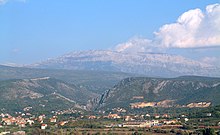Topography of Croatia

Topography of
Geomorphological units
The largest part of Croatia consists of lowlands, with elevations of less than 200 metres (660 feet) above sea level recorded in 53.42% of the country. Bulk of the lowlands are found in the northern regions of the country, especially in Slavonia, representing a part of the Pannonian Basin. Territory with elevations of 200 to 500 metres (660 to 1,640 feet) above sea level encompasses 25.61% of Croatia's territory, and the areas between 500 and 1,000 metres (1,600 and 3,300 feet) above sea level cover the 17.11% of the country. Further 3.71% of the land is situated at 1,000 to 1,500 metres (3,300 to 4,900 feet) above sea level, and only 0.15% of Croatia's territory lies at elevations greater than 1,500 metres (4,900 feet) above sea level.[1] The greatest concentration of ground at relatively high elevations is found in Lika and Gorski Kotar areas in the Dinaric Alps, but such areas are found in all regions of Croatia to some extent.[2] The Pannonian Basin and the Dinaric Alps, along with the Adriatic Basin represent major geomorphological parts of Croatia.[3]
Adriatic Basin

Croatia's Adriatic Sea mainland coast is 1,777.3 kilometres (1,104.4 miles) long, while its 1,246 islands and islets encompass further 4,058 kilometres (2,522 miles) of coastline. The distance between the extreme points of Croatia's coastline is 526 kilometres (327 miles).[4] The number of islands includes all islands, islets, and rocks of all sizes, including ones emerging at ebb tide only.[5] The islands include the largest ones in the Adriatic—Cres and Krk, each covering 405.78 square kilometres (156.67 square miles), and the tallest—Brač, whose peak reaches 780 metres (2,560 feet) above sea level. The islands include 48 permanently inhabited ones, the most populous among them being Krk and Korčula.[1]
The shore is the most indented coastline in the Mediterranean.
Dinaric Alps

Formation of the
| Highest mountain peaks of Croatia[1] | |||
|---|---|---|---|
| Mountain | Peak | Elevation | Coordinates |
| Dinara | Dinara | 1,831 m (6,007 ft) | 44°3′N 16°23′E / 44.050°N 16.383°E |
| Biokovo | Sveti Jure | 1,762 m (5,781 ft) | 43°20′N 17°03′E / 43.333°N 17.050°E |
| Velebit | Vaganski vrh | 1,757 m (5,764 ft) | 44°32′N 15°14′E / 44.533°N 15.233°E |
| Plješivica | Ozeblin | 1,657 m (5,436 ft) | 44°47′N 15°45′E / 44.783°N 15.750°E |
| Velika Kapela | Bjelolasica – Kula |
1,533 m (5,030 ft) | 45°16′N 14°58′E / 45.267°N 14.967°E |
| Risnjak | Risnjak | 1,528 m (5,013 ft) | 45°25′N 14°45′E / 45.417°N 14.750°E |
| Svilaja | Svilaja | 1,508 m (4,948 ft) | 43°49′N 16°27′E / 43.817°N 16.450°E |
Snježnik |
Snježnik | 1,506 m (4,941 ft) | 45°26′N 14°35′E / 45.433°N 14.583°E |
Pannonian Basin

The
The results of those processes are large plains in the eastern Slavonia,
See also
References
- ^ ISSN 1333-3305. Retrieved 28 January 2012.
- ^ "Land use - State and impacts (Croatia)". European Environment Agency. Retrieved 2 March 2012.
- Ministry of Construction and Spatial Planning (Croatia). November 2006. Retrieved 2 March 2012.
- ISBN 978-1-897643-22-8. Retrieved 26 January 2012.
- ^ Josip Faričić; Vera Graovac; Anica Čuka (June 2010). "Croatian small islands – residential and/or leisure area". Geoadria. 15 (1). University of Zadar: 145–185. Retrieved 28 January 2012.
- ISBN 978-1-4020-0888-7.
- ISSN 1331-2294. Retrieved 28 January 2012.
- ISBN 978-1-86239-252-6.
- PMC 2121601.
- ISSN 0277-3791.
- ^ Branimir Vukosav (30 April 2011). "Ostaci prastarog vulkana u Jadranu" [Remains of an ancient volcano in the Adriatic Sea]. Zadarski list (in Croatian). Retrieved 24 February 2012.
- ^ ISSN 1868-4556.
- ISBN 978-0-12-383833-9. Retrieved 3 March 2012.
- ^ Mate Matas (18 December 2006). "Raširenost krša u Hrvatskoj" [Presence of Karst in Croatia]. geografija.hr (in Croatian). Croatian Geographic Society. Archived from the original on 9 June 2012. Retrieved 18 October 2011.
- ^ "The best national parks of Europe". BBC. 28 June 2011. Archived from the original on 4 August 2012. Retrieved 11 October 2011.
- ^ "Postojna više nije najdulja jama u Dinaridima: Rekord drži hrvatska Kita Gaćešina" [Postojna is no longer the longest cave in the Dinarides: The record is held by Croatia's Kita Gaćešina] (in Croatian). index.hr. 5 November 2011. Retrieved 3 March 2012.
- ISBN 978-94-007-2447-1. Retrieved 2 March 2012.
- ISBN 978-90-5011-276-5.
- Papuk Geopark. Retrieved 2 March 2012.
